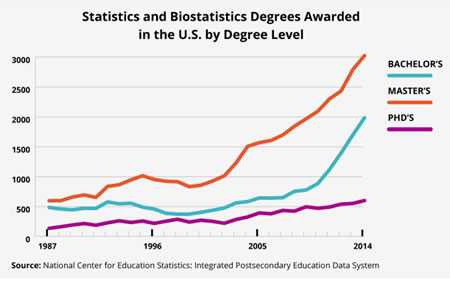NCES reveals that the growing data science field can pull from an incredible number of statistics majors, but it’s still not enough.
 Increasing by more than 300 percent since the 1990s, the number of undergraduates in statistics degree programs is hurtling the major into the fastest growing in the U.S. But the growth may not be enough to satisfy the high demand for technology-based fields like data science and database management—which could spell trouble for colleges and universities anxious to effectively analyze massive amounts of big data.
Increasing by more than 300 percent since the 1990s, the number of undergraduates in statistics degree programs is hurtling the major into the fastest growing in the U.S. But the growth may not be enough to satisfy the high demand for technology-based fields like data science and database management—which could spell trouble for colleges and universities anxious to effectively analyze massive amounts of big data.
Delving into newly released data from the National Center for Education Statistics’ (NCES) “Integrated Postsecondary Education Data System Completions Survey and NSF/NCSES: Survey of Earned Doctorates,” the information shows that bachelor’s degrees in statistics grew 17 percent from 2013 to 2014, marking 15 consecutive years the number of undergrads in statistics has risen.
For comparison, while the number of undergraduates earning statistics degrees has increased by more than 300 percent since the 1990s, the number of undergrads earning science and engineering degrees grew by 72 percent over the same period.

Yet, notes the American Statistical Association (ASA), which analyzed the NCES data, the demand for statisticians, especially in the field of data science and management, is likely to outpace this growth.
According to ASA’s research within the Bureau of Labor Statistics’ (BLS) data, total employment for statisticians has grown from 28,000 positions in 2010 to 85,000 in 2014. Also, BLS projects job growth for statisticians will increase 27 percent between 2012 and 2022, outpacing the projected 11 percent rate for all other occupations.
In an ASA press release, the organization states that while these figures may be conservative because they do not include the many jobs that require substantial expertise in statistics (data scientist, market research analyst, etc.), the number of graduates in statistics each year—approximately 2,000 bachelor’s degrees, 3,000 master’s degrees and 575 doctorate degrees—seems unlikely to match this demand.
“We’re entering an era of tremendous growth in the profession of statistics that is not unlike the growth of computing professionals in the 1960s and 1970s,” explained ASA President David R. Morganstein in a statement. “At that time, software engineers and programmers were still relatively rare, but grew quickly and steadily as computing became something every large company needed to remain competitive. We’re seeing a similar trajectory in statistics. Advances in computing, technology and Big Data continue to raise the demand for statisticians.”
In a 2011 report, notes the ASA, McKinsey Global Institute said a “significant constraint on realizing value from Big Data will be a shortage of talent, particularly of people with deep expertise in statistics and machine learning,” and predicted a potential shortage in the U.S. of 140,000 to 190,000 workers with deep analytical skills by the year 2018. It also warned of an additional shortage of 1.5 million managers and analysts who can use the analytical output of Big Data for decision-making.
And while Morganstein explained that ASA and its membership acknowledge that data science encompasses more than statistics, they also recognize that statistical science plays a critical role in the fast-growing field. “It is our hope that [our] statement will reinforce the relationship of statistics to data science and further foster mutually collaborative relationships among all key contributors in data science.”
Not Lost on Academia
Though the lack of consensus on what constitutes data science is frustrating, ASA believes statistics professionals are “foundational” to many fields important to higher education’s success in the future:
- Database Management, which enables transformation, conglomeration, and organization of data resources
- Statistics and Machine Learning, which convert data into applicable knowledge
- Distributed and Parallel Systems, which provide the computational infrastructure to carry out data analysis and forecasting
The need for colleges and universities to turn massive amounts of data into effective effort is an increasingly important issue (Read here and here), and more institutions are heeding the call to action.
For instance, Harvard University, says ASA, has seen enrollments in its statistics department courses more than double since 2005. Joe Blitzstein, Harvard University co-director of undergraduate studies and professor of statistics, says enrollment in his course, Stat 110, has increased six fold since 2005.
“More and more employers are recognizing the invaluable skills of statisticians in today’s data-intensive world,” he said. “More and more students are realizing the power and versatility of a statistics degree or training for pursuing a wide range of careers, from data science and finance to health and the environment.”
Another example is Brigham Young University, which retooled its program in response to increased demand for statisticians. Today, it offers three undergraduate degrees in statistics: one that prepares students for graduate work, one for actuarial careers and one for applied statistics geared toward jobs in Big Data that require courses in programming.
Statistics department chair Dennis Tolley says the number of matriculating students has more than doubled over the last six years, and employer participation in career fairs at the school has roughly quadrupled.
ASA also notes that the number of universities granting degrees in statistics also has grown, increasing by 50 percent for bachelor’s degrees and 20 percent for master’s degrees from 2003 to 2014. And, for the first time, degrees in data science are being offered. Six universities recently established such programs, including the University of Michigan and the University of California, Irvine.
And while the fields of statistics and data science also offer high annual salaries (mean annual salary for statisticians is $84,010), major companies, such as LinkedIn, have begun highlighting the importance of statistics professionals. LinkedIn named “statistical analysis and data mining” one of the “hottest skills that got people hired,” and job site CareerCast and advocacy organization Young Invincibles recently named statistics in separate reports as one of the best careers for millennials based on factors like pay, growth and job satisfaction.
Increasing the Increase
“For statisticians to help meet the statistical challenges faced by data scientists requires a sustained and substantial collaborative effort with researchers with expertise in data organization and in the flow and distribution of computation,” said ASA leadership in a joint statement. “Statisticians must engage them, learn from them, teach them and work with them. Engagement must occur at all levels: with individuals, groups of researchers, academic departments and the [data science] profession as a whole.”
New problem-solving strategies are also needed, they emphasized, to develop “soup-to-nuts” pipelines that “start with managing raw data and end with user-friendly efficient implementations of principled statistical methods and the communication of substantive results. Engendering these next-generation strategies will be fostered from the ground up in data science and statistics programs at colleges and universities across the country.”
In short, explained ASA leadership, while capacity is increasing within existing and innovative new degree programs, more is needed to meet the massive expected demand.
“The next generation must include more researchers with skills that cross the traditional boundaries of statistics, databases and distributed systems; there will be an ever-increasing demand for such ‘multi-lingual’ experts.”
Material from a press release was used in this article.
- 25 education trends for 2018 - January 1, 2018
- IT #1: 6 essential technologies on the higher ed horizon - December 27, 2017
- #3: 3 big ways today’s college students are different from just a decade ago - December 27, 2017

